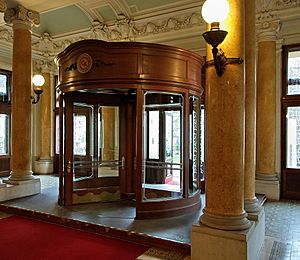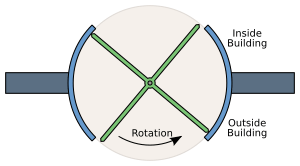Revolving door facts for kids
A revolving door is a special type of door that spins around a central pole. It has several panels, usually three or four, that let people enter or exit a building one by one.

Revolving doors are often used in big buildings like offices, hotels, and stores. They are very good at saving energy. When you open a regular door, a lot of warm air can escape in winter, or cool air can escape in summer. Revolving doors act like an airlock, stopping too much air from moving in or out. This helps keep the building's temperature steady and saves on heating or cooling costs.
Contents
History of Revolving Doors
The idea for a revolving door is quite old! The first person to get a patent for a "door without airflow" was H. Bockhacker in Germany in 1881. This early design was meant to stop drafts.
Later, in 1888, an American named Theophilus Van Kannel also got a patent for his own design. He called his invention a "storm door." His design was very similar to the revolving doors we see today.
Challenges with Revolving Doors
While revolving doors are great for saving energy, they can have some problems.
Speed and Safety
When a revolving door starts spinning, it can make people walk at a certain speed. This can be tricky for some people. If someone can't keep up, they might fall and get hurt.
Accessibility
Revolving doors are also hard or impossible for people using a wheelchair to use. People who are blind might also find them difficult to navigate safely.
Emergency Exits
In an emergency, like a fire, people need to get out of a building very quickly. Revolving doors are not good for fast exits because only one or two people can go through at a time. For these reasons, most countries have rules that buildings with revolving doors must also have regular "push" doors nearby. You often see these regular doors on either side of a revolving door in hotels and public places.
Turnstiles
Sometimes, you'll see doors that look a bit like revolving doors but are called turnstiles. These are often used at places like sports stadiums, theme parks, or subways.
Turnstiles usually let people exit freely but stop them from entering without a ticket or payment. They often have horizontal bars that spin, allowing one person through at a time. This helps control who comes in and out, making sure everyone pays or has permission to enter.
Images for kids
-
A revolving door in Turkey
See also
 In Spanish: Puerta giratoria para niños
In Spanish: Puerta giratoria para niños







